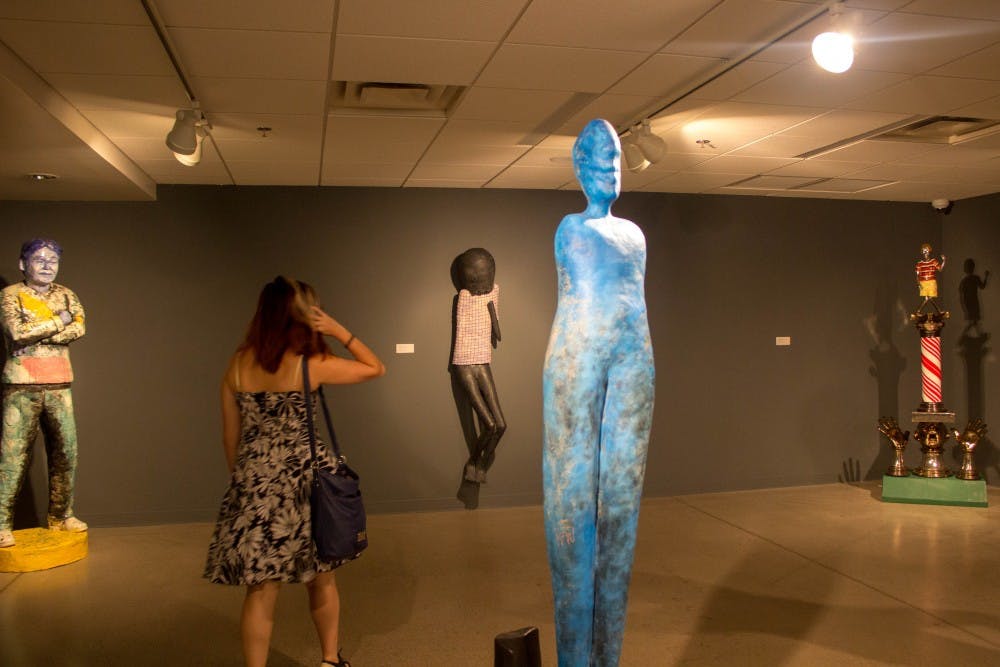The ASU Art Museum’s Ceramics Research Center is hosting an exhibition titled ‘From Darkness to Light’ focusing on the vast range of human emotions.
The exhibition, which opened Oct. 6 and runs until Feb. 19, features sculptures and prints by 31 different ceramic artists depicting human figures in the throes of various emotional displays.
Claire Curneen, whose work is featured in the exhibition, said artists’ continued attachment to ceramics lies in humanity’s roots.
“If you think of clay in terms of a material itself, clay is ancient,” she said. “The first artifacts were clay. The first things that made us culturally human apparently were tools, but clay – that’s where we first made art, where we made icons, images. Ceramics comes out of that.”
Mary-Beth Buesgen, the curator of the exhibition and the Ceramics Research Center program and facility specialist , said clay allows artists to portray action and emotion in a uniquely relatable style different from any other artistic practice.
“Clay is just a very willing medium to use to portray the human form and it's very forgiving, so that you can rework something until you actually get that emotion or that statement or whatever it is that you're trying to portray,” she said. “I think with ceramics in general … everyone can identify with it. Everyone uses a mug, everyone uses a plate. So it's something that they understand.”
Curneen said her work, which often draws inspiration from Italian Renaissance paintings, projects increasing isolation and numbness in humans as society is repeatedly bombarded with images of tragedy from a wide variety of media outlets.
She also said her work’s simplicity and lack of identifying features, like hair or color outside of the natural white of porcelain, allows viewers from all walks of life to relate to her pieces.
“I usually make work that talks about loss, a sense of identity, what it is to be human, what it is to be a woman, what it is to be just somebody today, really,” she said. “I think everything I do talks about the day-to-day things of what it’s like to just get on with life and the ordinariness of things, and how do we make that extraordinary?”
Tom Bartel, another artist featured in the exhibition, said his work takes a humorous approach to the transition from youth to old age.
His figure stands in a box, which is now empty but he said was originally filled with dirt, symbolizing a coffin. The figure also sports party hat shaped nipples on a young body, portraying a youthful immaturity to offset the darker symbols of mortality.
“I grew up in the Midwest and there didn't seem to be a lot of signifiers or rites of passage (for growing up) … so I was making my own version of that sort of important life event,” he said. “And so that's why I feel like the piece is really self-reflective. I don't think it's a self-portrait, but it sort of helped me as a person to navigate some of the complexity of navigating early adulthood.”
Bartel said he, like Curneen, kept certain aspects of his figure’s wrinkled, elderly face ambiguous to allow all viewers to find a connection to his work.
“If there's a blank expression … people can kind of project their own baggage onto the piece,” he said. “If that piece had an ear-to-ear grin, people are probably going to get that, that would be a really effective decision, but it's also quite limited. So I always sort of felt like there was something nice about providing just enough information but not too much information.”
Buesgen said she hopes the exhibition motivates more students to learn about the Ceramics Research Center and its permanent collection.
“It's just a huge resource for students,” she said. “We just need to get the word out as far as where we're located and that it's there for everyone to use.”
Reach the reporter at mrobbin9@asu.edu or follow @MelissaARobbins on Twitter.
Like The State Press on Facebook and follow @statepress on Twitter.




